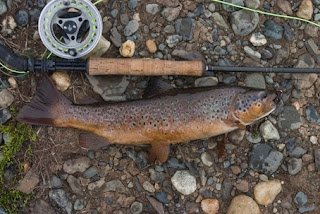Lago Blanco is a big water body - 24 km long and up to 8 km wide. Same as other big Patragonian lakes, it is created by a glacier. In its western part the lake is surrounded by the mountains. Here it is more narrow and deep; its banks are indented, with coves and bays. The eastern part of the lake, where the glacier was coming out into the plain, the lake hollow is more open and wide. Lago Blanco is very clear. It is populated by brown and rainbow trout. The record brown trout from the lake was over 13 kg.
On the first day there was no wind. On such days Patagonian trout is becoming unusually wary, and requires light tackle and thin tippets.
Regardless to the fall (mid March), the day was hot. We were able to catch some small trout, casting long lines with small dark wet flies.
In a long trip it is often necessary to replenish the stock of the flies. The ones most popular among the local trout were the Wooly Buggers, which are easy to tie even without a vise.
On the second day the weather at the lake was rather nasty, windy and rainy.
The lake outlet (boca) of the Lago Blanco - this river is called Rio Blanco. The first 200 meters of the stream below the lake is used for spawning by king salmon. It is one of two known Atlantic stocks of this Pacific salmon. This population has origin from the stray fish from Chilean waters, where king salmon was stocked in the end of 20 century.
Rio Blanco is very clear. The beech trees along its banks are killed by the beavers.





















































